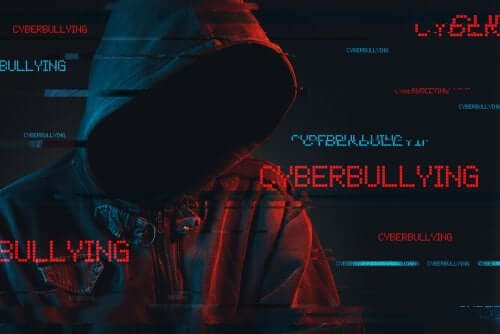Cybernetic Crimes During Adolescence

Without a doubt, you’ve heard about terms like online bullying or cyberbullying. However, there are many other types of crimes that have to do with the misuse of the internet, cell phones, and other digital technologies. In this article, we’ll tell you what you need to know about cybernetic crimes.
In recent years, Information and Communication Technologies (ICT) have become an essential part of our everyday lives. Whether it’s a smart TV, a cell phone, a tablet, or a computer, we’re permanently connected to some electronic device or another.
This affects teenagers in particular, who sometimes misuse new technology. In fact, cybernetic crimes during adolescence are becoming more and more frequent every day.
Cybernetic crimes during adolescence
In this day and age, the lives of teenagers revolve around different forms of technology. Many teens are completely dependent on their cell phones and different social media platforms.
This can end up being very dangerous, given the high risk of misusing Information and Communication Technologies (ICT). Unfortunately, it’s common for constant ICT use to cause adolescents to develop a sense of impunity and anonymity. And, as a result, many end up taking part in antisocial behaviors through their screens and even committing cybernetic crimes.

Types of cybernetic crimes
Most cybernetic crimes that teenagers commit have to do with humiliation, threats, sex, extortion, etc. These crimes fall into the following categories:
- Sextortion: This refers to the blackmailing and bullying that a person suffers when another threatens to use a sexual image of him or her inappropriately. The person committing the crime may have obtained the image legally or illegally. This type of crime usually involves threatening to make the image public or send it to an audience in particular (such as the individual’s parents).
- Sexting: This term refers to sending erotic messages, images, or videos to someone else using email, social media, text messaging, etc. In and of itself, sexting isn’t a crime. However, it is a crime when someone spreads the content of sexting without the authorization of the person or persons who sent it.
- Cyberstalking: Stalking is the continuous and intrusive persecution of another person against their will. Cyberstalking, in particular, refers to stalking someone through new technologies.

More types of cybernetic crime
- Grooming: Grooming is a set of actions that an adult practices via the internet in order to fool minors and establish a relationship of supposed trust and friendship. However, the adult’s true intentions are sexual in nature. Eventually, the adult starts to solicit pornographic and erotic images and videos from the minor in question.
- Cracking: Cracking is the modification of software in an attempt to control someone else’s electronic devices. This allows them to discover who the person talks to, who they’re in contact with, where they are, etc. This type of cybernetic crime is especially common among adolescent couples.
- Cyberbullying: Cyberbullying refers to the constant and repeated humiliation and threatening of someone via the internet, cell phone, and other digital technologies. This doesn’t only happen during school hours, but at any time, day or night. This type of bullying can include other cybernetic crimes, such as sextortion, cyberstalking, etc.
Different expressions of cyberbullying
According to Cristobal Torres, José Manuel Robles and Stefano de Marco, all of the following behaviors are different expressions of cyberbullying:
- Posting compromising photos or videos of the victim (these photos may be real, or they may be the result of editing).
- Uploading a photo of the victim to a website as a means of exposing him or her to stigma or ridicule.
- Creating a false profile using the victim’s name on social media, forums, etc.
- Participating aggressively in chats acting as the victim.
- Providing a person’s email address to certain websites so that he or she will receive spam and/or contact from strangers, etc.
- Stealing a person’s email password, social media password, etc. in order to violate his or her privacy.
- Spreading rumors on social media, accusing someone of questionable, offensive or disloyal behavior.
- Sending threatening messages to the victim using electronic devices.
- Stalking the victim on websites and social media platforms that he or she uses habitually.
It’s important for parents to talk to their children about these types of crimes and monitor their internet use as much as possible. That way, you can help protect them from becoming victims and prevent them from becoming aggressors.
Without a doubt, you’ve heard about terms like online bullying or cyberbullying. However, there are many other types of crimes that have to do with the misuse of the internet, cell phones, and other digital technologies. In this article, we’ll tell you what you need to know about cybernetic crimes.
In recent years, Information and Communication Technologies (ICT) have become an essential part of our everyday lives. Whether it’s a smart TV, a cell phone, a tablet, or a computer, we’re permanently connected to some electronic device or another.
This affects teenagers in particular, who sometimes misuse new technology. In fact, cybernetic crimes during adolescence are becoming more and more frequent every day.
Cybernetic crimes during adolescence
In this day and age, the lives of teenagers revolve around different forms of technology. Many teens are completely dependent on their cell phones and different social media platforms.
This can end up being very dangerous, given the high risk of misusing Information and Communication Technologies (ICT). Unfortunately, it’s common for constant ICT use to cause adolescents to develop a sense of impunity and anonymity. And, as a result, many end up taking part in antisocial behaviors through their screens and even committing cybernetic crimes.

Types of cybernetic crimes
Most cybernetic crimes that teenagers commit have to do with humiliation, threats, sex, extortion, etc. These crimes fall into the following categories:
- Sextortion: This refers to the blackmailing and bullying that a person suffers when another threatens to use a sexual image of him or her inappropriately. The person committing the crime may have obtained the image legally or illegally. This type of crime usually involves threatening to make the image public or send it to an audience in particular (such as the individual’s parents).
- Sexting: This term refers to sending erotic messages, images, or videos to someone else using email, social media, text messaging, etc. In and of itself, sexting isn’t a crime. However, it is a crime when someone spreads the content of sexting without the authorization of the person or persons who sent it.
- Cyberstalking: Stalking is the continuous and intrusive persecution of another person against their will. Cyberstalking, in particular, refers to stalking someone through new technologies.

More types of cybernetic crime
- Grooming: Grooming is a set of actions that an adult practices via the internet in order to fool minors and establish a relationship of supposed trust and friendship. However, the adult’s true intentions are sexual in nature. Eventually, the adult starts to solicit pornographic and erotic images and videos from the minor in question.
- Cracking: Cracking is the modification of software in an attempt to control someone else’s electronic devices. This allows them to discover who the person talks to, who they’re in contact with, where they are, etc. This type of cybernetic crime is especially common among adolescent couples.
- Cyberbullying: Cyberbullying refers to the constant and repeated humiliation and threatening of someone via the internet, cell phone, and other digital technologies. This doesn’t only happen during school hours, but at any time, day or night. This type of bullying can include other cybernetic crimes, such as sextortion, cyberstalking, etc.
Different expressions of cyberbullying
According to Cristobal Torres, José Manuel Robles and Stefano de Marco, all of the following behaviors are different expressions of cyberbullying:
- Posting compromising photos or videos of the victim (these photos may be real, or they may be the result of editing).
- Uploading a photo of the victim to a website as a means of exposing him or her to stigma or ridicule.
- Creating a false profile using the victim’s name on social media, forums, etc.
- Participating aggressively in chats acting as the victim.
- Providing a person’s email address to certain websites so that he or she will receive spam and/or contact from strangers, etc.
- Stealing a person’s email password, social media password, etc. in order to violate his or her privacy.
- Spreading rumors on social media, accusing someone of questionable, offensive or disloyal behavior.
- Sending threatening messages to the victim using electronic devices.
- Stalking the victim on websites and social media platforms that he or she uses habitually.
It’s important for parents to talk to their children about these types of crimes and monitor their internet use as much as possible. That way, you can help protect them from becoming victims and prevent them from becoming aggressors.
All cited sources were thoroughly reviewed by our team to ensure their quality, reliability, currency, and validity. The bibliography of this article was considered reliable and of academic or scientific accuracy.
- Betancourt, A. (2014). Prevención del acoso escolar: Bullying y Ciberbullying. Costa Rica: Instituto Interamericano de Derechos Humanos.
- Calmaestra, J., Escorial, A., García, P., Del Moral, C., Perazzo, C., y Ubrich, T. (2016). Yo a eso no juego. Bullying y cyberbullying en la infancia. Madrid: Save the Children.
- Pérez de Miguel, P. (2014). La violencia de género a través de las nuevas tecnologías (Trabajo de fin de grado). Universidad de Jaén, Jaén.
- Torres, C., Robles, J. M., y De Marco, S. (2013). El ciberacoso como forma de ejercer la violencia de género en la juventud: un riesgo en la sociedad de la información y del conocimiento. Madrid: Delegación del Gobierno para la Violencia de Género.
This text is provided for informational purposes only and does not replace consultation with a professional. If in doubt, consult your specialist.








